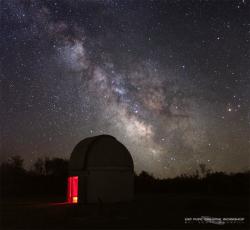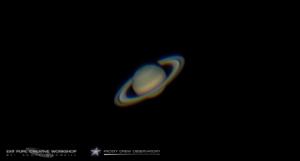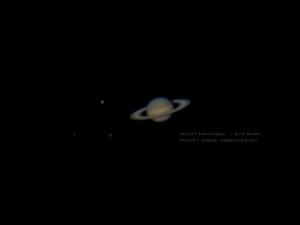
Public Stargazing
- Where:
- Frosty Drew Observatory
- When:
- Friday April 25, 2014 at 7:00 p.m.
- Cost:
- $1 Suggested Donation per Person
Tonight's forecast is calling for partly cloudy skies to start with heavier clouds moving in overnight. The 8% waning crescent Moon does not rise until 4:20 a.m. and would have left us super dark skies for an awesome night of stargazing. We plan to open tonight at 7:00 p.m. in the Sky Theatre with a presentation on objects we would typically be viewing this time of year featuring astro-photographs shot at Frosty Drew Observatory. The Observatory will open at 8:00 p.m. starting off with Jupiter and Mars if the skies are clear enough. Stay up to date on conditions at the observatory with the @FrostyDrewOBSY Twitter. Even though we are in quite a long stretch of cloudy Friday nights, we remain optimistic as the Spring and early Summer are the best viewing seasons at Frosty Drew. The stunningly bright Milky Way is now rising in the early morning hours and will continue to rise earlier with each coming night, eventually becoming visible all night long. Awesome nights await the explorer in all of us.
-------------------------------------------------------------------------
Weekly Happenings
Scott MacNeill
As we say our goodbye's to the long overbearing Winter that brought in 2014 we will also soon part skies with Jupiter, which has been with us all Winter. Jupiter has been receiving less than its usual share of attention these days as Mars rocks the skies with spectacular views of the martian landscape, atmosphere, and polar cap. While the Mars party is taking place, another awesome planet, and easily the most popular, has been sneaking into the nighttime sky – Saturn.
With its mesmerizing rings, celebrity moons, and apparent increase in axial tilt; Saturn is surely the hottest planet to observe at Frosty Drew. Among all the excellent attributes Saturn has to offer, the best is probably the apparent tilt of the rings. Like Earth, Saturn has an axial tilt. Earth's axial tilt is 23.4° which gives us late Summer sunsets, winter wonderlands, and traffic sourcing leaf-peeping joy. Well Saturn has an axial tilt of 26.7° which allows for similar seasons on Saturn. But more excitingly it allows us to see Saturn's rings at a different inclination every viewing season. Saturn's year (orbit around the Sun) takes about 29 Earth years. So over the course of 29 years we will see Saturn's rings tilted 26.7° away from the Sun and every year for 7 years decrease in tilt until the rings become “edge-on” or nearly invisible from our point of view. At this point the inclination of Saturn's rings will appear to increase for the next 7 years until Saturn's rings appear tilted 26.7° towards the Sun. The next 15 years the inclination of Saturn's rings decrease back to on-edge then increase back to 26.7° away from the Sun. This year Saturn's rings will be further inclined towards the Sun reaching their maximum apparent inclination in 2017.
On May 10th Saturn will be at opposition which means Saturn is on the opposite side of Earth than the Sun and, consequently, its closest point to Earth for the year. We had our first view of Saturn at Frosty Drew a couple weeks ago and it looked killer! Be sure to set some time aside this Spring – Summer to be blown away by the amazing views Saturn has to offer.
Coming back to Frosty Drew on Saturday May 3rd is the annual Frosty Drew Classic 5k Run / Walk. This is a huge fund raising event for Frosty Drew Observatory and is essential in keeping us open every Friday night offering free celestial awesomeness for all who care to be mesmerized. Grab those running shoes and kick off Spring with a brisk run / walk through the beautiful park lands of Ninigret Park and help support the best night-sky show in town. Visit Frosty Drew Classic 5k Run / Walk to learn more about this excellent event.
This week is International Dark Sky Week, which is about raising awareness to the increasing loss of the night sky over planet Earth. In Charlestown, we have the darkest skies in the state of Rhode Island, Southern New England, and are a contender for the darkest spot on the New England coast line. Charlestown's skies are stunning to say the least and the Charlestown community has stepped up their game with the passing of a lighting ordinance in 2012 designed to keep the skies dark over Charlestown. Have you experienced the awe and humility of the Milky Way galaxy stretched out before you? If not, put Frosty Drew on your list of absolute places to visit in 2014 and be awestruck with the rest of us!
-Scott


